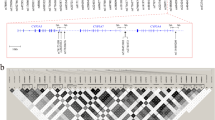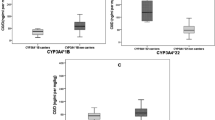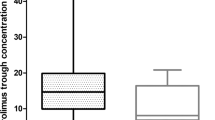Abstract
Genetic association studies on the pharmacokinetics of tacrolimus have reported conflicting results, except for the role of the CYP3A5*3 polymorphism. The objective of this study was to identify genetic variants affecting the pharmacokinetics of tacrolimus using the DMETTM Plus microarray in 42 healthy males. Aside from CYP3A5*3, the rs3814055 polymorphism in the NR1I2 gene was associated with the tacrolimus pharmacokinetics based on false discovery rate-corrected multiple tests and the least absolute shrinkage and selection operator analysis. The area under the concentration-time curve to the last quantifiable time point (AUClast) was 3.42 times greater in subjects with homozygous mutations in both genes (CYP3A5*3/*3 and NR1I2 T/T) than in wild-type subjects. The two variants explained the 54% variability in the tacrolimus AUClast. An in vitro luciferase reporter assay indicated that downregulation of PXR expression is the likely molecular mechanism responsible for the increased exposure to tacrolimus in subjects carrying the rs3814055 C>T variant.
This is a preview of subscription content, access via your institution
Access options
Subscribe to this journal
Receive 6 print issues and online access
$259.00 per year
only $43.17 per issue
Buy this article
- Purchase on Springer Link
- Instant access to full article PDF
Prices may be subject to local taxes which are calculated during checkout


Similar content being viewed by others
References
Hesselink DA, Bouamar R, Elens L, van Schaik RH, van Gelder T . The role of pharmacogenetics in the disposition of and response to tacrolimus in solid organ transplantation. Clin Pharmacokinet 2014; 53: 123–139.
Food and Drug Administration (US). Draft Guidance on Tacrolimus [Internet]. 2014 [updated 2014; cited 1 June 2015]. Available from http://www.fda.gov/downloads/drugs/guidancecomplianceregulatoryinformation/guidances/ucm406344.pdf.
The Phamarcogenomics Knowledgebase (US). Tacrolimus_PGx research [Internet]. [updated 2015; cited 1 Jun 2015]. Available from https://www.pharmgkb.org/drug/PA451578#tabview=tab1&subtab=31.
Birdwell KA, Decker B, Barbarino JM, Peterson JF, Stein CM, Sadee W et al. Clinical pharmacogenetics implementation consortium (CPIC) guidelines for CYP3A5 genotype and tacrolimus dosing. Clin Pharmacol Ther 2015; 98: 19–24.
Tabor HK, Risch NJ, Myers RM . Candidate-gene approaches for studying complex genetic traits: practical considerations. Nat Rev Genet 2002; 3: 391–397.
Hirschhorn JN, Daly MJ . Genome-wide association studies for common diseases and complex traits. Nat Rev Genet 2005; 6: 95–108.
Yi S, An H, Lee H, Lee S, Ieiri I, Lee Y et al. Korean, Japanese, and Chinese populations featured similar genes encoding drug-metabolizing enzymes and transporters: a DMET Plus microarray assessment. Pharmacogenet Genomics 2014; 24: 477–485.
Gaur S, Wang Y, Kretzner L, Chen L, Yen T, Wu X et al. Pharmacodynamic and pharmacogenomic study of the nanoparticle conjugate of camptothecin CRLX101 for the treatment of cancer. Nanomedicine 2014; 10: 1477–1486.
Birdwell KA, Grady B, Choi L, Xu H, Bian A, Denny JC et al. The use of a DNA biobank linked to electronic medical records to characterize pharmacogenomic predictors of tacrolimus dose requirement in kidney transplant recipients. Pharmacogenet Genomics 2012; 22: 32–42.
Ratain MJ, Cox NJ, Henderson TO . Challenges in interpreting the evidence for genetic predictors of ototoxicity. Clin Pharmacol Ther 2013; 94: 631–635.
The Cocrane Collaberation (UK). Controlling for Confounding [Internet]. [updated on 2011; cited on 1 June 2015]. Available from http://handbook.cochrane.org/chapter_13/13_6_2_1_controlling_for_confounding.htm.
Zhou H, Alexander DH, Sehl ME, Sinsheimer JS, Sobel EM, Lange K . Penalized regression for genome-wide association screening of sequence data. Pac Symp Biocomput 2011: 106–117.
Bush WS, Moore JH . Chapter 11: Genome-wide association studies. PLoS Comput Biol 2012; 8: e1002822.
Bickel PJ, Brown JB, Huang H, Li Q . An overview of recent developments in genomics and associated statistical methods. Philos Trans A Math Phys Eng Sci 2009; 367: 4313–4337.
Wu TT, Chen YF, Hastie T, Sobel E, Lange K . Genome-wide association analysis by lasso penalized logistic regression. Bioinformatics 2009; 25: 714–721.
Aslibekyan S, Brown EE, Reynolds RJ, Redden DT, Morgan S, Baggott JE et al. Genetic variants associated with methotrexate efficacy and toxicity in early rheumatoid arthritis: results from the treatment of early aggressive rheumatoid arthritis trial. Pharmacogenomics J 2014; 14: 48–53.
Tibshirani R . Regression shrinkage and selection via the Lasso. J R Stat Soc B Methodol 1996; 58: 267–288.
Ramakrishna NV, Vishwottam KN, Puran S, Manoj S, Santosh M, Wishu S et al. Liquid chromatography-negative ion electrospray tandem mass spectrometry method for the quantification of tacrolimus in human plasma and its bioanalytical applications. J Chromatogr B Analyt Technol Biomed Life Sci 2004; 805: 13–20.
Andrews E, Armstrong M, Tugwood J, Swan D, Glaves P, Pirmohamed M et al. A role for the pregnane X receptor in flucloxacillin-induced liver injury. Hepatology 2010; 51: 1656–1664.
Benjamini Y, Hochberg Y . Controlling the false discovery rate - a practical and powerful approach to multiple testing. J R Stat Soc B Methodol 1995; 57: 289–300.
Clinical Annotation for rs776746 and tacrolimus [Internet]. [Available from https://www.pharmgkb.org/clinicalAnnotation/981203719.
Burk O, Koch I, Raucy J, Hustert E, Eichelbaum M, Brockmoller J et al. The induction of cytochrome P450 3A5 (CYP3A5) in the human liver and intestine is mediated by the xenobiotic sensors pregnane X receptor (PXR) and constitutively activated receptor (CAR). J Biol Chem 2004; 279: 38379–38385.
Dring MM, Goulding CA, Trimble VI, Keegan D, Ryan AW, Brophy KM et al. The pregnane X receptor locus is associated with susceptibility to inflammatory bowel disease. Gastroenterology 2006; 130: 341–348, quiz 592.
Martinez A, Marquez A, Mendoza J, Taxonera C, Fernandez-Arquero M, Diaz-Rubio M et al. Role of the PXR gene locus in inflammatory bowel diseases. Inflamm Bowel Dis 2007; 13: 1484–1487.
Fanta S, Jonsson S, Karlsson MO, Niemi M, Holmberg C, Hoppu K et al. Long-term changes in cyclosporine pharmacokinetics after renal transplantation in children: evidence for saturable presystemic metabolism and effect of NR1I2 polymorphism. J Clin Pharmacol 2010; 50: 581–597.
Chung JY, Cho JY, Lim HS, Kim JR, Yu KS, Lim KS et al. Effects of pregnane X receptor (NR1I2) and CYP2B6 genetic polymorphisms on the induction of bupropion hydroxylation by rifampin. Drug Metab Dispos 2011; 39: 92–97.
Benkali K, Premaud A, Picard N, Rerolle JP, Toupance O, Hoizey G et al. Tacrolimus population pharmacokinetic-pharmacogenetic analysis and Bayesian estimation in renal transplant recipients. Clin Pharmacokinet 2009; 48: 805–816.
Barraclough KA, Isbel NM, Lee KJ, Bergmann TK, Johnson DW, McWhinney BC et al. NR1I2 polymorphisms are related to tacrolimus dose-adjusted exposure and BK viremia in adult kidney transplantation. Transplantation 2012; 94: 1025–1032.
Bergmann TK, Hennig S, Barraclough KA, Isbel NM, Staatz CE . Population pharmacokinetics of tacrolimus in adult kidney transplant patients: impact of CYP3A5 genotype on starting dose. Ther Drug Monit 2014; 36: 62–70.
Bruckmueller H, Werk AN, Renders L, Feldkamp T, Tepel M, Borst C et al. Which Genetic Determinants Should be Considered for Tacrolimus Dose Optimization in Kidney Transplantation? A Combined Analysis of Genes Affecting the CYP3A Locus. Ther Drug Monit 2015; 37: 288–295.
Lamba J, Lamba V, Strom S, Venkataramanan R, Schuetz E . Novel single nucleotide polymorphisms in the promoter and intron 1 of human pregnane X receptor/NR1I2 and their association with CYP3A4 expression. Drug Metab Dispos 2008; 36: 169–181.
Thompson EE, Kuttab-Boulos H, Yang L, Roe BA, Di Rienzo A . Sequence diversity and haplotype structure at the human CYP3A cluster. Pharmacogenomics J 2006; 6: 105–114.
Liu J, Wang K, Ma S, Huang J . Accounting for linkage disequilibrium in genome-wide association studies: A penalized regression method. Stat Interface 2013; 6: 99–115.
Zuo XC, Zhou YN, Zhang BK, Yang GP, Cheng ZN, Yuan H et al. Effect of CYP3A5*3 polymorphism on pharmacokinetic drug interaction between tacrolimus and amlodipine. Drug Metab Pharmacokinet 2013; 28: 398–405.
Acknowledgements
This study was sponsored by a research grant from Chong Kun Dang Pharmaceutical, Seoul, Korea, and by a research grant for new faculty settlement, Seoul National University, Seoul, Korea.
Author information
Authors and Affiliations
Corresponding author
Ethics declarations
Competing interests
The authors declare no conflict of interest.
Additional information
Supplementary Information accompanies the paper on the The Pharmacogenomics Journal website
Supplementary information
PowerPoint slides
Rights and permissions
About this article
Cite this article
Choi, Y., Jiang, F., An, H. et al. A pharmacogenomic study on the pharmacokinetics of tacrolimus in healthy subjects using the DMETTM Plus platform. Pharmacogenomics J 17, 174–179 (2017). https://doi.org/10.1038/tpj.2015.99
Received:
Revised:
Accepted:
Published:
Issue Date:
DOI: https://doi.org/10.1038/tpj.2015.99
This article is cited by
-
Pharmacogenetics of Membrane Transporters of Tacrolimus in Solid Organ Transplantation
Clinical Pharmacokinetics (2019)
-
LBEC0101, A Proposed Etanercept Biosimilar: Pharmacokinetics, Immunogenicity, and Tolerability Profiles Compared with a Reference Biologic Product in Healthy Male Subjects
BioDrugs (2017)



